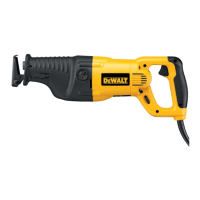7
ENGLISH
WARNING: Use extra caution when cutting overhead and
pay particular attention to overhead wires that may be
hidden from view. Anticipate the path of falling branches
and debris ahead oftime.
WARNING: Inspect work site for hidden gas pipes, water
pipes, or electrical wires before making blind or plunge
cuts. Failure to do so may result in explosion, property
damage, electric shock, and/or serious personalinjury.
Sawing Up to a Projecting Edge (Fig.F)
Using a conventional blade installed upside down, cut up to the
projectededge.
Cutting Plastics
Always work at reduced speed. Carry out a test cut to check
whether the material is sensitive toheat.
Cutting Metal
When cutting thin metal always stabilize the workpiece with
wood on both sides. This guarantees clean cuts and prevents
damaging of thematerial.
For long, straight cuts draw a line on theworkpiece.
Apply a thin film of lubricant along the cutting line, switch on
the tool and follow the cuttingline.
Pocket/Plunge Cutting – Wood Only (Fig.E)
The initial step in pocket cutting is to measure the surface area
to be cut and mark clearly with a pencil, chalk or scriber. Use
the appropriate blade for the application. The blade should
be longer than 90mm and should extend past the shoe and
the thickness of the workpiece during the cut. Insert blade in
bladeclamp.
Next, tip the saw backward until the back edge of the shoe
is resting on the work surface and the blade clears the work
surface (position 1, Fig. E). Now switch motor on, and allow
saw to come up to speed. Grip saw firmly with both hands and
begin a slow, deliberate upward swing with the handle of the
saw, keeping the bottom of the shoe firmly in contact with
the workpiece (position 2, Fig. E). Blade will begin to feed into
material. Always be sure blade is completely through material
before continuing with pocketcut.
NOTE: In areas where blade visibility is limited, use the edge
of the saw shoe as a guide. Lines for any given cut should be
extended beyond edge of cut to bemade.
Flush-To Cutting (Fig.F)
The compact design of the saw motor housing permits
extremely close cutting to floors, corners and other
difficultareas.
Cutting (Fig. E, F)
WARNING: Always use eye protection. All users and
bystanders must wear approved eyeprotection.
WARNING: Exercise extra caution when cutting towards
operator. Always hold saw firmly with both hands
whilecutting.
Before cutting any type of material, be sure it is firmly anchored
or clamped to prevent slipping. Place blade lightly against
work to be cut, switch on saw motor and allow it to obtain
maximum speed before applying pressure. Whenever possible,
the saw shoe must be held firmly against the material being
cut (Fig.F). This will prevent the saw from jumping or vibrating
and minimise blade breakage. Any cuts that put pressure on the
blade such as angle or scroll cuts increase potential for vibration,
kickback, and bladebreakage.
Switching On and Off (Fig.A)
To run the tool, press the variable speed switch
1
. The pressure
exerted on the variable speed switch determines the toolspeed.
To stop the tool, release theswitch.
Always switch off the tool when work is finished and
beforeunplugging.
Setting the Electronic Sawing Speed (Fig.A)
The speed control dial
2
can be used for advance setting of the
required range ofspeed.
Turn the electronic speed control dial to the required level. The
required setting depends on the thickness and kind ofmaterial.
Use high speeds for sawing soft materials such as wood. Use
low speeds for sawingmetal.
WARNING: After using the tool for an extended period
on low speed settings, run it for approx. 3 minutes on
maximum no‑loadspeed.
Proper Hand Position (Fig. F)
WARNING: To reduce the risk of serious personal injury,
ALWAYS use proper hand position asshown.
WARNING: To reduce the risk of serious personal
injury, ALWAYS hold securely in anticipation of a
suddenreaction.
Proper hand position requires one hand on the side front
grip
11
, with the other hand on the back
handle
13
.
OPERATION
Instructions for Use
WARNING: Always observe the safety instructions and
applicableregulations.
WARNING: To reduce the risk of serious personal
injury, turn tool off and disconnect tool from power
source before making any adjustments or removing/
installing attachments or accessories. An accidental
start‑up can causeinjury.
Cutting Masonry
WARNING: When sawing asbestos cement hazardous
dust may be produced. Follow the statutory guidelines
and observe the recommendations issued by the asbestos
cementmanufacturers.

